Learn
Analyzing Fingerprints
When found at a crime scene, fingerprints are a very valuable form of physical evidence. Like DNA, fingerprints are unique to an individual and do not change over time. Even identical twins do not have the same fingerprints.


Ridge Patterns
Fingerprints contain both individual and class characteristics.
Ridge patterns are class evidence and used to quickly sort fingerprints and eliminate suspects. There are three types of ridge patterns — loop, whorl, and arch -- which are then broken down into subcategories.
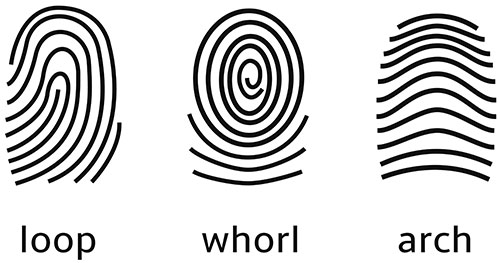
Deltas
The number of deltas is important in classifying fingerprint types. A delta is where three ridge lines meet at one point to create a triangular area (like the Greek symbol Delta "Δ"). It is the result of two parallel lines diverging to flow around the loop or whorl.
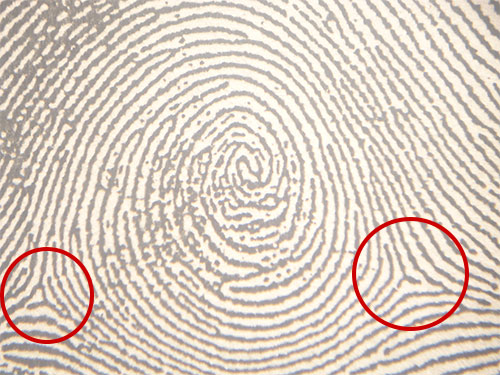

Loops
In a loop, the ridge lines enter and exit from the same side of the finger. Loops are named for the side of the finger that they enter and exit from.
- If they enter and exit from the thumb, they are known as radial loops.
- If they enter and exit from the pinky side, they are known as ulnar loops.
These names refer to the bones in the lower arm. The ulnar bone is on the pinky side while the radius bone is on the thumb side. It is necessary to know if the print is from the right or left hand when determining the type of loop.

Loops have only one delta.
Loops Example
Let's look at the fingerprints on this hand.

Pinky Fingerprint: Loop enters and exits towards the thumb, making it a radial loop
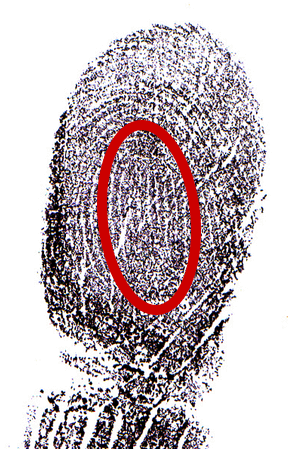
Ring Finger Fingerprint: Loop enters and exits towards the pinky, making it an ulnar loop
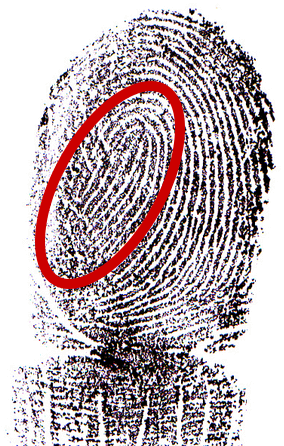
Middle Finger Fingerprint: Loop enters and exits towards the pinky, making it an ulnar loop

Index Finger Fingerprint: Loop enters and exits towards the pinky, making it an ulnar loop
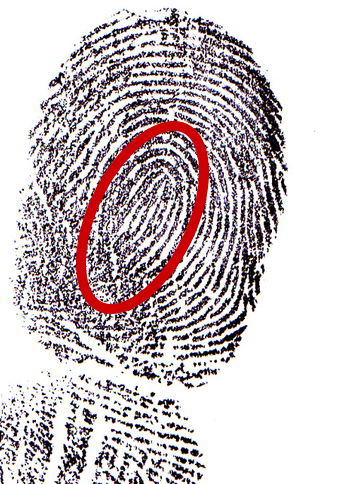
Thumb Fingerprint: No major loop
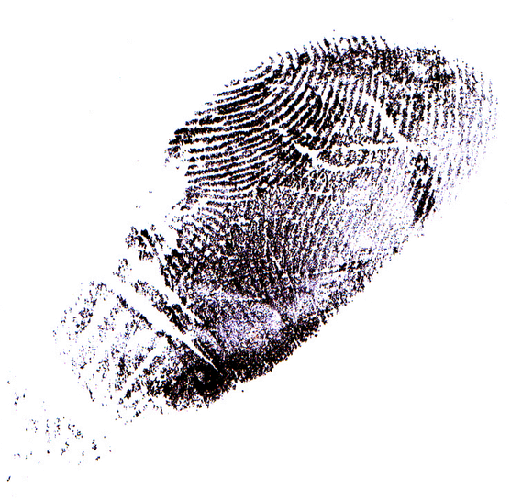
Whorls
In a whorl, there is at least one ridgeline that makes a complete circle around the finger. There are four unique types of whorls, but all whorls have at least 2 deltas.
- Plain whorl: This is the simplest and most common whorl. There is one complete circuit with a spiral or circular shape. An imaginary line drawn between the two deltas crosses the inner pattern area.
- Central pocket whorl: This is the same as a plain whorl but tighter. An imaginary line drawn between the two deltas does not cross the central pocket.
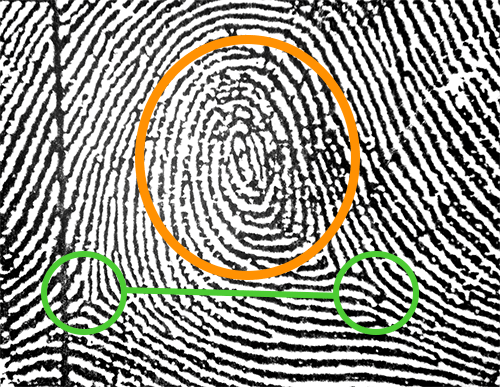

In the central pocket whorl (top), the line between the two deltas does not intersect with the central pocket, but it does in the plain whorl (bottom). See larger version of the central pocket whorl here and a larger version of the plain whorl here. "Central Pocket Loop Whorl in a right little finger" and "Plain whorl in a right thumbprint" by Metrónomo are licensed under CC BY-SA 4.0 and have been adapted from the originals. - Double loop: Two loops combine to make a whorl pattern.

Double loop whorl - Accidental whorl: Includes whorls that do not fit into the other categories.
Arches
In an arch, the ridges enter on one side and exit on the other. No deltas are present in this pattern. There are two types of arches:
- Tented arches tend to rise sharply in the center (like a tent).
- Plain arches rise subtly (like an ocean wave).

Knowledge Check #1
Approximately 60% of people have loops, while 35% have whorls and only 5% have arches. Look at your thumb. What type of fingerprint do you have?
- Loop
- Arch
- Whorl
Answer: There isn't a correct answer! Can you identify the subcategory of your fingerprint?
Knowledge Check #2
Describe the following fingerprints.
Ridge Patterns:
- central pocket whorl
- plain whorl
- double loop whorl
- tented arch
- plain arch
- radial loop
- ulnar loop
- accidental whorl
Fingerprints:
Answers:
- Central pocket whorl:

- Plain whorl:
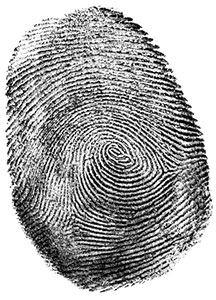
- Double loop whorl:
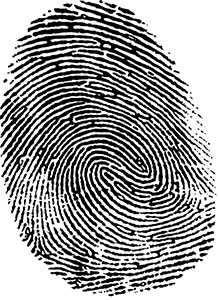
- Tented arch:

- Plain arch:

- Radial loop:
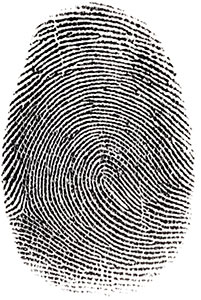
- Ulnar loop:

- Accidental whorl:
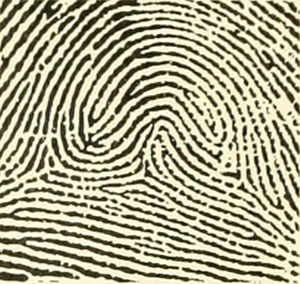
Ridge Characteristics
Ridge patterns, such as loop, whorl, and arch are types of fingerprints and represent _______blank (Answer: class characteristics).
Individual characteristics are found in the minutiae, which are the details of the fingerprint. While many people have the same ridge pattern, no two people will have the same minutiae characteristics in the same location.
Ridge Dot or Island
Ridge Dot or Island = Fingerprint that contains a dot with two ridge lines.
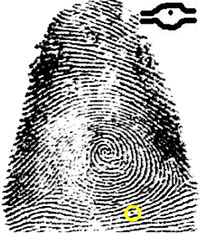
Bifurcation or Fork
Bifurcation or Fork = One friction ridge branches off and divides into two friction ridges. This is like a delta but does not create the triangular shape.
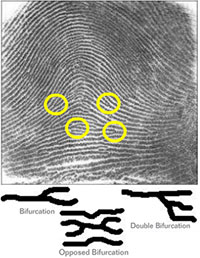
Ending Ridge
Ending Ridge = Where the ridge of the fingerprint stops.
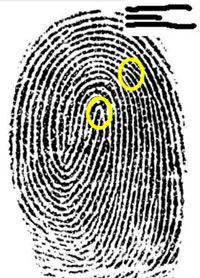
Ridge Crossing or Crossover
Ridge Crossing or Crossover = Where two ridges of the fingerprint cross, forming an X pattern.

Encloser (lake or eye)
Encloser (lake or eye) = When a ridge breaks in two and then joins back into one a short time later. This looks like an oval or an eye.
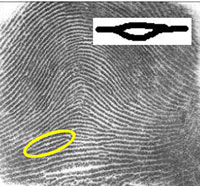
Short Ridge (island)
Short Ridge (island) = A short ridge in a fingerprint looks like an island.

Spur (hook)
Spur (hook) = This part of a fingerprint looks like a hook coming off another ridge.

Bridge
Bridge = When a ridge connects two ridges, like a bridge.

Delta
Delta = A triangle-like area usually where three ridge lines diverge from one point.

The Fingerprint Ridge Patterns and Characteristics charts summarizes the class and individual characteristics of fingerprints. It would be helpful to print this to reference in future tasks.
The quality of the print determines if enough of these individual characteristics will be discernable in the print to make a positive match. Criminal courts require 8 to 12 minutiae matches for fingerprints to be used as evidence in a criminal case.
Knowledge Check #3
Identify the ridge characteristics to properly label the indicated minutiae.
Ridge Characteristics:
- Bifurcation
- Bridge
- Eye
- Ending ridge
- Short ridge
Minutiae Locations on the Fingerprint:
- Red
- Blue
- Pink
- Orange
- Green
Answers:
- Red: Eye
- Blue: Short ridge
- Pink: Bifurcation
- Orange: Ending ridge
- Green: Bridge